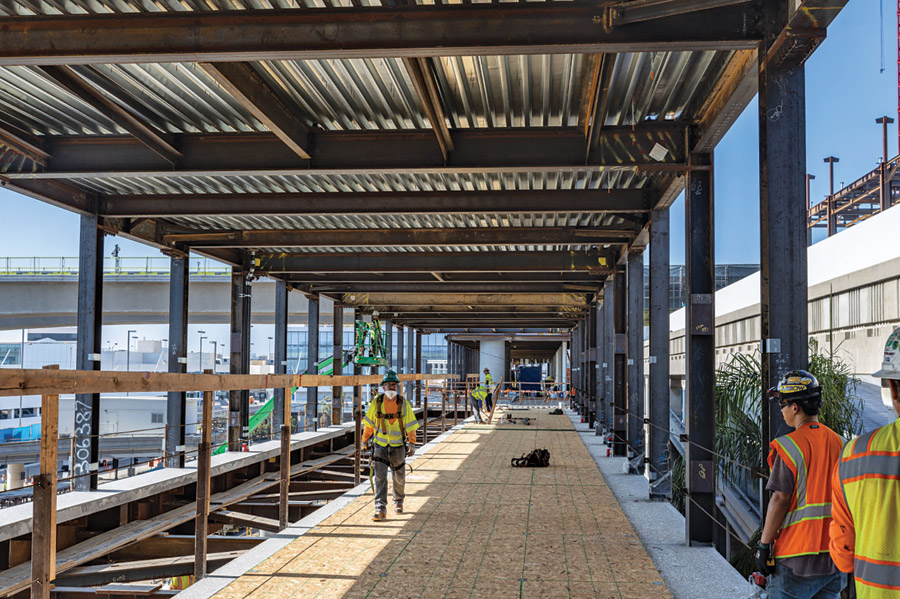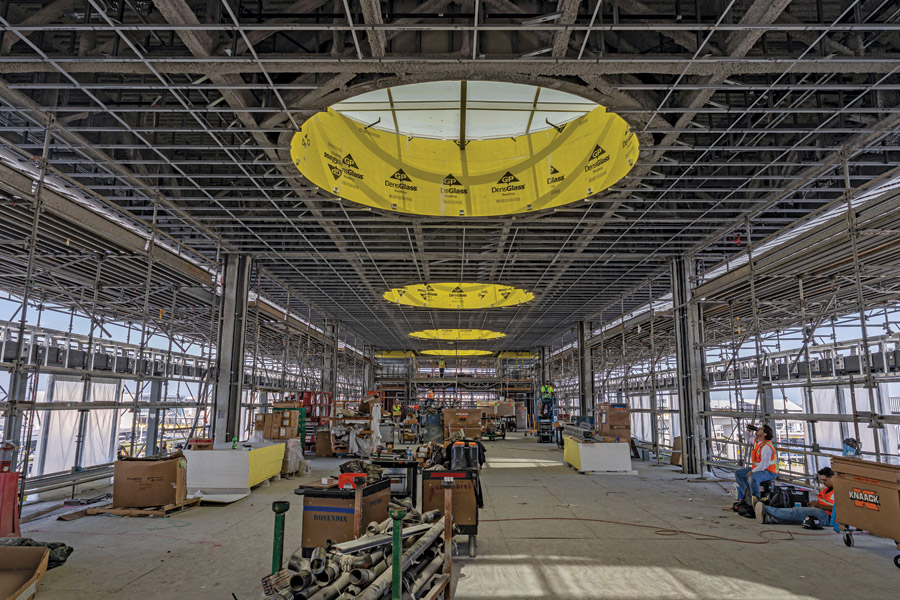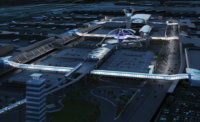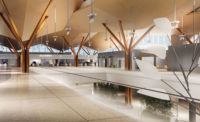Digging Deeper | Airports/Transit
LAX $5.5B Modernization Program Flying Ahead

The LAX Landside Modernization Program (LAMP) will completely revitalize the airport and prepare it for expected future demand.
Rendering courtesy of LAWA
When Los Angeles World Airports (LAWA) announced in August that the last structural steel beam was placed for the six automated people mover (APM) train stations, it was just the latest in a procession of construction milestones achieved over the past year for the $5.5-billion Landside Modernization Program (LAMP).
Billions of dollars of construction had already been ongoing over the past decade at Los Angeles International Airport (LAX), including an approximately $2-billion new midfield concourse, a $980-million revamp of Terminal 1 and a $546-million upgrade of Terminals 7 and 8.
But these were just the opening acts for the LAMP, which includes the $2-billion, 2.25-mile APM that will connect three on-airport stations to Metro Rail and transit services; a $2-billion consolidated rental car (ConRAC) facility; the $294-million Intermodal Transportation Facility-West; $490 million in “terminal vertical cores” that will allow pedestrian bridges to connect the APM stations to terminals; and roadway improvements. Other work at LAX includes the $2-billion revamp and merging of Terminals 2 and 3 for Delta Air Lines, $1.6 billion worth of upgrades to Terminals 4 and 5 and improvements to Terminal 1 totaling $230 million.

Six new pedestrian walkways will connect new APM stations with terminals.
Photo courtesy of LAWA
“Each one of these jobs by themselves would be monumental for an airport,” says Justin Erbacci, LAWA’s CEO. “We’re doing them all at the same time.”
The APM will connect to the city’s transit system via the Airport Metro Connector station at Aviation Boulevard and 96th Street, being built by LA Metro. The ITF-West facility opened in 2021, and the remaining LAMP elements should be delivered by 2023—well in time for the 2028 Olympics and Paralympics.
The largest of the six stations being built, the West Central Terminal Area (CTA) station, saw the last of nearly 2,000 tons of structural steel set in place with the August topping out. Days before, officials unveiled the first of 44 APM train cars, and in June they made the 6.4-million-sq-ft ConRAC facility available to tenants—a 233,000-sq-ft structure that is the second largest in the world after the Pentagon, according to LAWA officials. Also in the past few months, five of the six pedestrian bridges have been completed.

Revamp of original terminal is part of a project to combine and expand Delta’s presence.
Photo by Aileen Cho for ENR
Moving the People Mover
The Los Angeles City Council in spring 2018 approved a 30-year, $4.9-billion contract with LAX Integrated Express Solutions (LINXS) to design, build, finance, operate and maintain an automated people mover train system at Los Angeles International Airport (LAX)—the largest contract in the city’s history and the largest airport P3 at the time in the U.S.
LINXS, comprised of Fluor, Balfour Beatty, ACS Infrastructure Development, Dragados USA, HOCHTIEF PPP Solutions, Flatiron, HDR and HNTB, completed the guideway construction this year. The aerial structure, soaring up to 65 ft above ground and snaking its way through the congested airport, sits on cast-in-drilled-hole piles with diameters as wide as 11 ft and as deep as 80 ft, according to the LINXS team. Column heights are approximately 60 ft on the west half within the central terminal area (CTA) and 40 ft on the east.
Thirteen guideway segments are supported with cast-in-place, reinforced post-tensioned concrete columns. Each segment is supported by several columns where the connections are fixed within the guideway segment and supported by disk bearings at the ends.

Justin Erbachi, LAWA CEO, says another multibillion program is underway.
Photo by Aileen Cho for ENR
The trapezoidal box-girder superstructure spans over two main roadway arteries into the airport, Century Boulevard and Sepulveda Boulevard, and over an existing parking garage. Falsework was not an option since these main arteries and parking garage could not be closed. The segments in these areas were built using cast-in-place segmental box girder construction. The guideway span over Sepulveda Boulevard was built in 12 segments, each approximately 15 ft in length, culminating with a 7.5-ft closure pour. Almost 70,000 cu yd of concrete went into the guideway.
Superstructure spans range from 42 ft at the center CTA station to 272 ft over the parking garage. Width is typically 30 ft but wider at crossover switch locations and approaches to elevated stations. Depth of superstructure varies from 7 ft to 14 ft.
Three of the stations sit inside the CTA and three outside. The system will operate a maximum of nine four-car trains. The last structural beam placed in August was for the 1.2-million-sq-ft West CTA station sporting structural glass walls and coated metal cladding. It will connect the APM to Terminals 3, 4 and 5, in addition to Tom Bradley International Terminal, via elevated pedestrian bridges. It will feature an open space with a programmable 800-sq-ft LED screen and work by local artists.
From the West CTA station, the last stop on the route inside the CTA, it will take a six-minute ride to reach the LAX Economy Parking facility, eight minutes to the station that will connect to the future Airport Metro Connector Station and 10 minutes to the ConRAC facility during peak operations.
“Each one of these jobs by themselves would be monumental.”
—Justin Erbacci, CEO, LAWA
The first pedestrian bridge was installed in June 2021 at Terminals 4 and 5, connecting to the West CTA station. The second bridge followed in September at Terminal 2, connecting to the Center CTA station. In January, the third bridge was installed at Terminal 3, which will connect to the West CTA station. Partially prefabricated steel trusses, ranging in weight from 56,000 to 97,000 lb, were assembled and lifted into place with a 350-ton crane. This March, the fourth bridge was installed at Terminal 1, with 209,500 lb of partially prefabricated steel trusses assembled and lifted into place also with a 350-ton crane.
In April, the fifth pedestrian bridge, a structure over World Way that will eventually connect Terminals 5 and 6 to the CTA APM station, was placed with a redesign by LINXS. The bridge is a Vierendeel truss constructed out of horizontal and vertical support elements, eliminating the need for diagonal supports. The truss is made up of rectangular rather than triangular frames and employs moment joints to resist substantial bending forces. The result is a more streamlined, aesthetic profile.
Bridge placements typically took place over the course of four evenings, particularly during days when the night traffic was less, says Jake Adams, LAWA’s deputy executive director for LAMP. Installation of glass panels on the pedestrian bridges is now underway, to be followed by moving sidewalks later this year as well as installation of the last bridge connecting Tom Bradley International Terminal to the West CTA station.

ConRAC features spacious public areas and a direct connection to the APM station.
Photo courtesy of PCL
Concrete Behemoth
Built under a $2-billion, 28-year P3 with LAX ConRAC Partners (LAXCP), the ConRAC facility covers approximately 6.3 million sq ft and is comprised of the Ready Return/Idle Storage building, where customers will pick up and drop off their vehicles; an APM train station; and a Quick Turn Around building, where the rental car vehicles are serviced. A total of 233,000 cu yd of concrete was placed, making it the second-largest concrete building in the U.S. behind only the Pentagon. Crews poured the final structural concrete in April. The project utilized more than 56 million lb of reinforced steel and more than 703,000 sq ft of asphalt.
The Ready Return/Idle Storage building can hold 18,000 vehicles, including both rentals and employee parking. The five-story structure will house five rental car companies representing 13 brands. The Quick Turn Around building was this summer handed over to rental car tenants for fit-out, with the full project completing in the summer of 2023. Once the APM trains are running, they will remove approximately 3,200 daily shuttle trips from the busy terminal area and the surrounding roadways.
Design-builder PCL Construction Services Inc. built a concrete batch plant on site that reduced the number of truck deliveries by 80-90 vehicles per day. In 2020, construction peaked at 1,300 workers on site, says Todd Bourgeois, PCL senior superintendent. “We had 1,000-cu-yd concrete pours a day at peak,” he says.
Aside from the scenic plaza area, 60-ft escalators and rows of spaces for rental car facilities, the ConRAC is essentially “the world’s largest gas station,” says Bourgeois. The complex includes 186 fueling stations, 64 maintenance bays, seven 45,000-gallon tanks and 37 car washes. It also includes an 8,400-megawatt photovoltaic solar panel system and scores of electric vehicle charging stations.

The consolidated car rental facility is the second-largest concrete structure in the U.S. after the Pentagon.
Photo courtesy of LAWA
“Future-proofing our facilities is critical in ensuring our infrastructure can adapt to changing technology in the coming years,” says Adams. “One example of this type of innovation can be seen with our [ConRAC facility], which was built to allow flexibility with the space for uses such as commercial/retail development or autonomous vehicles.”
Completed last fall, the $294.1-million LAX Economy Parking facility, known as the Intermodal Transportation Facility-West (ITF-West) during construction, was the first component of the LAMP. The approximately 4,300-stall, four-story, 1.7 million-sq-ft facility provides a parking option for travelers looking to avoid the busy CTA garages. People can reserve their spot ahead of time on LAX’s new online reservation system, saving up to 60% off of drive-up rates ($30/day). A Smart Parking Indicator System guides vehicles to open parking spaces.
Built in a design-build contract with Swinerton Builders and Watry/Gensler as project architects/designers, the facility features both short- and long-term parking options, electric vehicle chargers and a meet and greet area where a shuttle picks up and drops off drivers. It also houses the security and badging office, which was previously located in a remote location inconvenient for employees, says Adams.
Adams says the facility will serve not only as a high-tech parking garage but as an intermodal center that will accommodate TNCs (transportation network companies) and shuttles to nearby hotels. A commercial plaza on the ground level will offer amenities and encourage people to spend time there while waiting for arriving passengers.
“The ConRAC is essentially the world’s largest gas station.”
—Todd Bourgeois, Senior Superintendent, PCL
Following closely on the heels of its $4-billion terminal revamp at LaGuardia International Airport, Delta Air Lines with LAX is well underway with a $2.3-billion effort to upgrade and combine Terminals 2 and 3 for a total of 27 gates. This includes complete replacement of the Terminal 3 concourse and original 1961 satellite concourse, a connection behind security between Terminal 3 and Tom Bradley International Terminal and connection to the APM. The general contractor for the project is Hensel Phelps, with Arup as engineer of record and Gensler serving as the architect. The project was originally slated to complete in 2024, but has been accelerated by approximately 18 months due to the downturn in passenger traffic caused by the pandemic and is now projected to complete in mid-2023.
“We were able to start the second phase of the program early during the pandemic. Where it was originally contemplated to do the two phases in series, we put them in parallel,” says Brian Frederick, managing director of design and construction for Delta. “Our design and CM teams were able to ramp up resources and pivot quickly to support Delta and LAWA’s vision. That did reduce some of our carrying and phasing costs, and those savings were put back into scope enhancements.”
“HireLAX pointed me in the right direction.”
—Kordero Dotson, Journeyman Carpenter
For example, a secure passenger connection between Terminal 3 and Tom Bradley International Terminal that allows passengers to walk from Terminal 1 to Terminal 8 completely behind security will now have moving walkways. “We designed the [connection to the international terminal] structure to accommodate future moving walkways, but they were previously out of scope. We were able to add them back in,” he says.
The new central headhouse, which opened in April, includes a consolidated check-in lobby, security checkpoint with automated screening lanes, a centralized baggage claim area and one of the largest Delta Sky Clubs at 30,000 sq ft. The first of three gates in the new Terminal 3 opened on May 25.
The project also includes two vertical cores that create vertical passenger circulation via elevators and escalators and connect to APM stations. Temporary walls allow for construction while passengers use existing gates, but eventually all walls will come down, says Frederick.

APM will connect to the consolidated car rental facility, the largest of its kind.
Photo courtesy of LAWA
Hiring Hardhats
There won’t be much of a break in LAX’s massive construction efforts, with a planned Airfield Modernization Program “just kicking off,” says Erbacci. Environmental work was completed last year, and RFPs are being issued for airfield and roadwork. The plan includes a nine-gate Concourse Zero and a 15-gate Terminal 9 totalling almost 3 million sq ft. A rough cost estimate tops out at $15 billion, but designs are still preliminary.
What seems certain is the continuation of the HireLAX program, a six-week program with Los Angeles Southwest College and the Los Angeles/Orange Counties Building and Construction Trades Council aimed at training disadvantaged Angelenos such as ex-cons and the homeless in the trades. Almost 80% of 200-plus graduates immediately entered the workforce, says Erbacci.

East CTA station will feature 20-ft-dia skylights and connect to Terminal 7 over a parking garage.
Photo courtesy of LAWA
Kordero Dotson, a journeyman carpenter, joined the first class. “HireLAX pointed me in the right direction. The speakers told us what to expect. It’s been real tough, but I built friendships that got me through,” he says. “I am extremely grateful for everything HireLAX, LAWA, LASC and the partners did for me.”
Ponciano Aquino, a carpenter apprentice, adds: “I am using the tools gained from [HireLAX] with my daughters to improve their futures. My youngest daughter may end up being the 2nd-generation carpenter in the family.”




